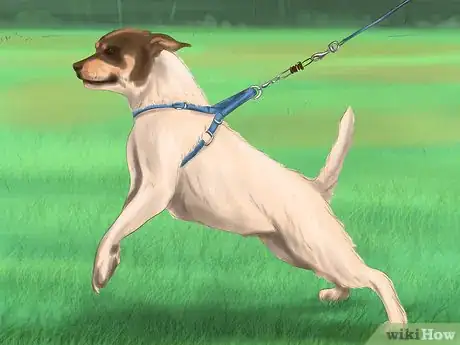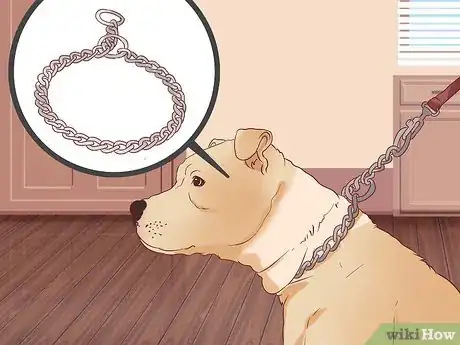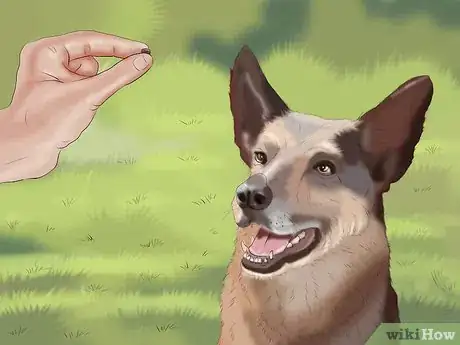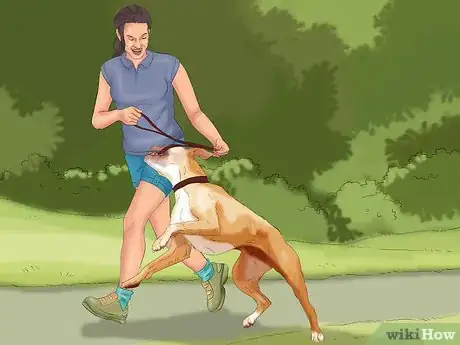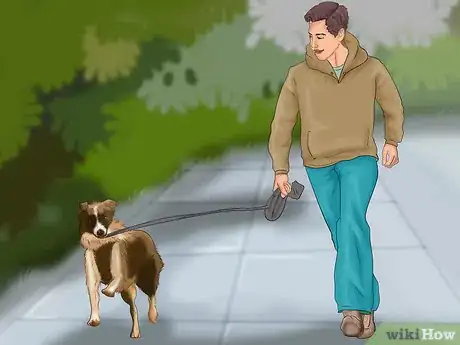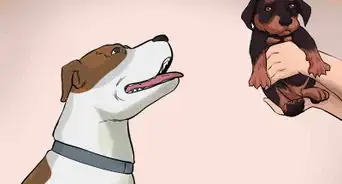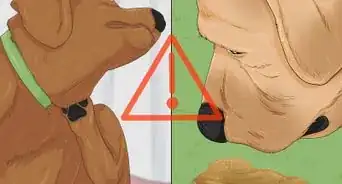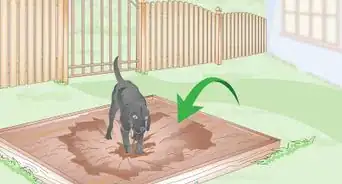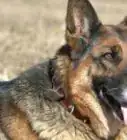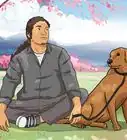This article was co-authored by David Levin. David Levin is the Owner of Citizen Hound, a professional dog walking business based in the San Francisco Bay Area. With over 9 years of professional dog walking and training experience, David's business has been voted the "Best Dog Walker SF" by Beast of the Bay for 2019, 2018, and 2017. Citizen Hound has also been ranked #1 Dog Walker by the SF Examiner and A-List in 2017, 2016, 2015. Citizen Hound prides themselves on their customer service, care, skill, and reputation.
There are 13 references cited in this article, which can be found at the bottom of the page.
This article has been viewed 13,672 times.
It's very unpleasant to walk an uncooperative dog, and it may even pose a physical risk to you and your dog. When your walks become a nightmare for you, it's important to know how you can you correct your dog's behavior. You can train your dog out of his or her undesirable behavior and try different leashes and collars to make your walks more safe and manageable.
Steps
Trying Different Types of Walking Equipment
-
1Use a halter on walks.[1] If your dog pulls, zigzags, or engages in any other type of undesirable behavior on walks, a halter might help. Halters are designed to redistribute pressure. When your dog pulls or veers off course, the halter pulls your dog's nose down and towards you to discourage uncooperative behavior.[2]
- Halters fit over the bridge of the nose and around the back of the head. They're easy to put on and they can make walks with your dog much easier.
- A halter will not hurt your dog. It simply makes it slightly uncomfortable if your dog tries to behave badly on a walk.
- You can buy a halter at most pet stores or online.
-
2Strap your dog into a harness.[3] Harnesses work similar to halters, but they strap around your dog's chest rather than on the head. There are several different types of harnesses, each with its own advantages and disadvantages. You can buy a harness at most pet stores or through an online retailer.
- Back-clip harnesses are not very effective at controlling or breaking behavioral issues. However, they are comfortable for dogs and won't injure the neck like a leash could if the dog pulls too hard.[4]
- Front-clip harnesses work much like back-clip harnesses, except they make it easier to control the dog's movement. The downside to front-clip harnesses is that they may cause your dog's legs to get tangled on walks.[5]
- Tightening harnesses can help control your dog's movement very well, but they won't actually train your dog to behave on a walk. Some tightening harnesses can be painful for dogs, so make sure you read reviews online and try it out on your dog before a walk.[6]
Advertisement -
3Consider trying a different type of collar. Collars typically fall into one of two categories: regular collars and aversive collars. Aversive collars, like choke chains and pronged collars, use pain or discomfort to try and break dogs out of bad behavior. Talk to your veterinarian or a professional trainer before using an aversive collar, as simple training may be more effective.[7]
- Flat collars are the standard strap-style collar most dogs wear.
- Martingale collars can be helpful for dogs that are able to slip out of a normal collar.
- A choke chain is a chain made of metal links that slips over the dog's head and tightens when your dog pulls. Choke chains are sometimes considered inhumane, as they can cause a dog to choke or sustain injuries to the neck, trachea, or esophagus.
- Prong/pinch collars work like a martingale collar, but they're lined with blunted metal prongs. Like choke chains, these collars are often considered inhumane.
Teaching Your Dog Not to Pull
-
1Practice walking your dog on-leash at home.[8] Pulling during walks may be a sign your dog is overly excited to go outside. If your dog associates being leashed up with an exciting adventure, he or she may be more likely to pull and lunge on your walk. By desensitizing your dog to being leashed up, you may be able to discourage your dog from pulling on the leash.[9]
- When you put on your dog's leash, do so silently and without any trigger words. The goal is to get your dog accustomed to being leashed up without getting excited.
- Leash up your dog between walks and stay indoors. Walk around the house with your dog on-leash as you read, watch TV, or just move about from room to room.
-
2Train your dog with a clicker. Clicker training is a common method of breaking dogs out of bad behavior. Using a clicker and plenty of treats when you walk your dog can help your dog associate good behavior with food rewards, which will reinforce good behavior over time.[10]
- Carry a clicker and dog treats on every walk.
- As you walk outside, wait at the door until your dog looks back at you. Don't give any verbal commands, and don't move until your dog looks at you.
- As soon as your dog looks at you, activate the clicker and give your dog a treat. Then stop every few steps on your walk, click the clicker, and reward your dog with another treat.
- Transition to stopping only when your dog begins to pull. When your dog stops pulling and turns to face you, activate the clicker and give your dog a treat.[11]
-
3Use treats to discourage pulling. If you don't like the idea of clicker training, you can try training your dog by just offering treats. Over time, your dog will learn that when he or she stops pulling you will offer more treats.[12]
- Carry some treats with you on walks. Keep a few treats in whichever hand is closest to your dog as you walk him or her.
- Give your dog a treat every so often if he or she is walking appropriately.
- Any time your dog begins to pull, stop walking and wait for your dog to look back at you.
- Once your dog stops, give the "sit" command. Hold the handful of treats in front of your dog's nose so he or she smells the treats, but don't give any treats until your dog starts behaving again.
-
4Be consistent in your training. If you let your dog get his or her way from time to time, your dog will pick up on this and act out accordingly. The goal in any type of training is to be consistent every time you walk so that your dog breaks out of his or her undesirable habit.[13]
Training Your Dog Not to Zigzag
-
1Pick a side and stick to it. If your dog zigzags during walks, your walking etiquette may be to blame. Dogs take behavioral cues from their humans, and your dog may not know which side you prefer if you alternate sides while you walk. Dogs need consistency to ensure good behavior, and that includes which side you walk your dog on.[14]
- Make a choice and be consistent. Whether you walk your dog on the right side or left side, make sure you stick with that side for every walk while you train your dog.
-
2Use a short leash. Using a short leash can be very helpful during training. Give your dog just a little slack, but not so much that your dog will be able to switch sides or weave between your legs. As your dog's training progresses you can work your way up to a normal leash length.[15]
- You can either buy a short leash, or simply keep your dog's leash reeled in to a shorter length.
-
3Teach your dog the "heel" command. Teaching your dog to heel may help break him or her out of zigzagging on walks. When you train your dog to heel, you reinforce the importance of following your lead and staying close to your body.[16]
- Stand at your dog's side and hold the leash in the hand closest to the dog. Carry a reward (either a squeaky toy or treats) in the other hand.
- Hold the reward above and just ahead of your dog's face so your dog can see it.
- Say "heel" and start walking. Make sure your dog walks in step with you and follows the reward.
- Any time your dog gets distracted, squeak the toy or hold the treats right in front of your dog's nose. Do this just long enough to regain your dog's attention and get back in step with one another.
- Every time your dog walks in step for 30 seconds, give your dog a reward (either play time with the toy or a treat). Gradually extend that length of time for your dog, and eventually you'll be able to get your dog to heel without treats.
-
4Work your way up to loose-leash walking. Loose-leash walking involves training your dog to walk as fast or as slow as you do. If your dog runs ahead or lags behind, using treats and stopping the walk can help teach your dog to follow your lead and defer to your desired speed.[17]
- Any time your dog starts pulling, stop walking forward and take a few steps backwards.
- As you step back, call your dog in a happy tone of voice. Give your dog a reward when he or she returns to your side.
- Give your dog rewards every three or four steps that he or she stays in synch with your pace.
- Gradually increase the number of steps your dog needs to take to get treats, then progress to random rewards once your dog has learned how to keep pace with you.
Community Q&A
-
QuestionWhat's the best way to get a stubborn dog to walk with me?
 David LevinDavid Levin is the Owner of Citizen Hound, a professional dog walking business based in the San Francisco Bay Area. With over 9 years of professional dog walking and training experience, David's business has been voted the "Best Dog Walker SF" by Beast of the Bay for 2019, 2018, and 2017. Citizen Hound has also been ranked #1 Dog Walker by the SF Examiner and A-List in 2017, 2016, 2015. Citizen Hound prides themselves on their customer service, care, skill, and reputation.
David LevinDavid Levin is the Owner of Citizen Hound, a professional dog walking business based in the San Francisco Bay Area. With over 9 years of professional dog walking and training experience, David's business has been voted the "Best Dog Walker SF" by Beast of the Bay for 2019, 2018, and 2017. Citizen Hound has also been ranked #1 Dog Walker by the SF Examiner and A-List in 2017, 2016, 2015. Citizen Hound prides themselves on their customer service, care, skill, and reputation.
Professional Dog Walker A head halter may be your best bet if your dog doesn't behave. A halter controls your dog's muzzle so you can easily lead your dog in the direction you want it to walk.
A head halter may be your best bet if your dog doesn't behave. A halter controls your dog's muzzle so you can easily lead your dog in the direction you want it to walk. -
QuestionI'm making a dog walking business, but I'm only 10. I'm not sure if I should walk big dogs. Would it be safe if I did?
 Community AnswerDepending on your size and strength, you could consider setting a weight limit on the dogs you'll walk. Another (and perhaps even better) option is to test walk each dog in the company of its owner before committing to walking it so you can get an idea of whether you can handle it.
Community AnswerDepending on your size and strength, you could consider setting a weight limit on the dogs you'll walk. Another (and perhaps even better) option is to test walk each dog in the company of its owner before committing to walking it so you can get an idea of whether you can handle it. -
QuestionI'm 11 and I want to start a dog walking business, but what should I do if the dog I walk is aggressive or uncooperative?
 Community AnswerBe firm. If the dog starts barking or lunging at something, pull back, sit it down, and say "No!" It may take many tries, but it should work. Make sure you don't take on dogs that you can't physically control (i.e. dogs that are very big), at least until you're more experienced.
Community AnswerBe firm. If the dog starts barking or lunging at something, pull back, sit it down, and say "No!" It may take many tries, but it should work. Make sure you don't take on dogs that you can't physically control (i.e. dogs that are very big), at least until you're more experienced.
Warnings
- Avoid using a choke or prong/pinch collar unless your vet says it is safe, as collars like these can cause serious injuries to dogs.⧼thumbs_response⧽
- Don't pull too hard on the leash. Pulling can choke your dog and may cause neck injuries.⧼thumbs_response⧽
References
- ↑ David Levin. Professional Dog Walker & Trainer. Expert Interview. 19 December 2019.
- ↑ http://www.humanesociety.org/animals/dogs/tips/how_to_use_head_halter.html
- ↑ David Levin. Professional Dog Walker & Trainer. Expert Interview. 19 December 2019.
- ↑ http://www.vetstreet.com/our-pet-experts/harnessing-the-walk-choosing-the-right-harness-for-your-dog
- ↑ http://www.vetstreet.com/our-pet-experts/harnessing-the-walk-choosing-the-right-harness-for-your-dog?page=2
- ↑ http://www.vetstreet.com/our-pet-experts/harnessing-the-walk-choosing-the-right-harness-for-your-dog?page=3
- ↑ http://www.humanesociety.org/animals/dogs/tips/collars.html
- ↑ David Levin. Professional Dog Walker & Trainer. Expert Interview. 19 December 2019.
- ↑ http://moderndogmagazine.com/articles/five-quick-tips-stop-your-dog-pulling-leash/20193
- ↑ http://smartdoguniversity.com/how-to-deal-with-a-stubborn-dog-full-article/
- ↑ David Levin. Professional Dog Walker & Trainer. Expert Interview. 19 December 2019.
- ↑ https://clevelandapl.org/behaviorhelp/teaching-your-dog-not-to-pull-on-a-leash/
- ↑ https://clevelandapl.org/behaviorhelp/teaching-your-dog-not-to-pull-on-a-leash/
- ↑ http://www.vetstreet.com/our-pet-experts/how-can-i-teach-my-dog-not-to-zigzag-in-front-of-me-on-walks
- ↑ http://www.vetstreet.com/our-pet-experts/how-can-i-teach-my-dog-not-to-zigzag-in-front-of-me-on-walks?page=2#1_xpowlje8
- ↑ http://www.akc.org/learn/akc-training/teach-your-puppy-these-5-basic-commands/#heel
- ↑ http://www.akc.org/learn/akc-training/whos-walking-who-tips-to-teach-loose-leash-walking/
About This Article
If your dog is uncooperative when you take it on walks, try using treats to discourage pulling. While you walk, give your dog a treat every so often when it is walking appropriately. Any time it begins to pull, stop walking and wait for it to stop and look back at you. Then, give it the “sit” command and let it smell and see the treats in your hand, but don’t give it one until it starts behaving again. If your dog pulls and lunges too much on walks because of excitement, try leaving its leash on at home between walks to make the leash seem less exciting so it won’t trigger unruly behavior. In addition to training methods, you might consider using a halter or harness instead of your regular leash. When your dog pulls or veers off course, the halter pulls its nose down and towards you to discourage uncooperative behavior. The harness straps around your dog’s chest and makes it easier to control its movement. For more tips from our Veterinary co-author, like how to train your dog with a clicker, keep reading!


